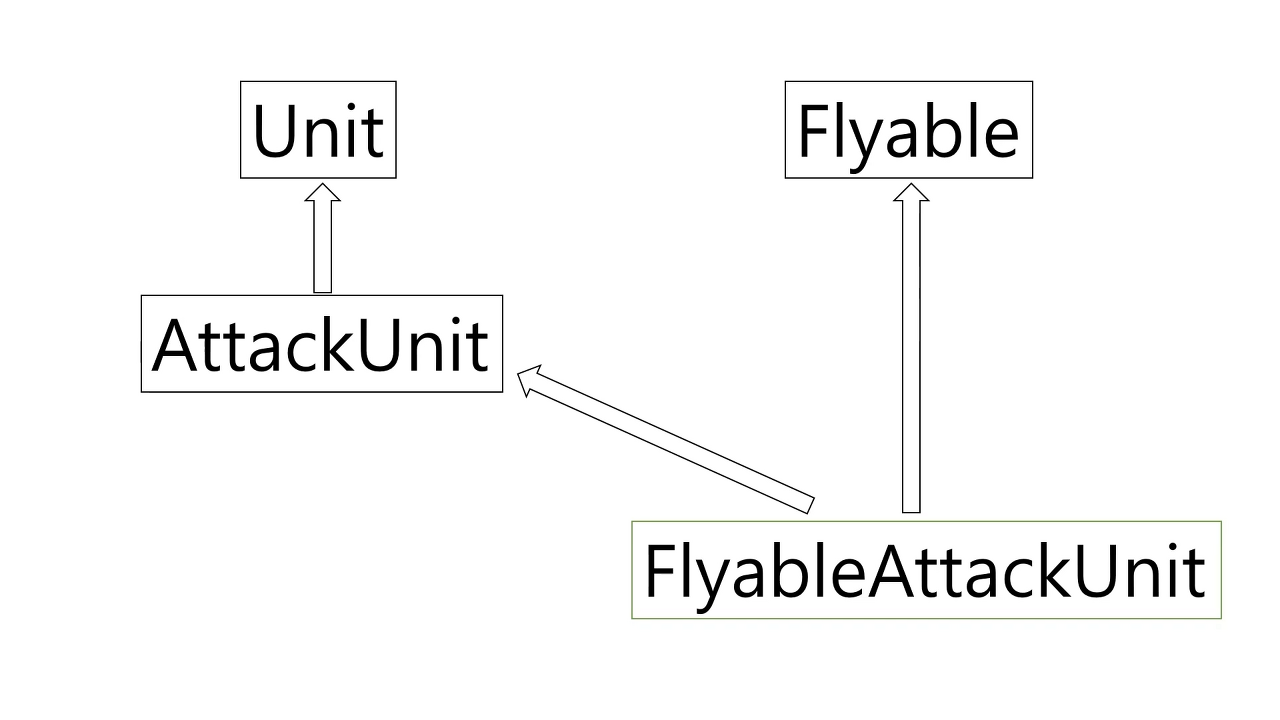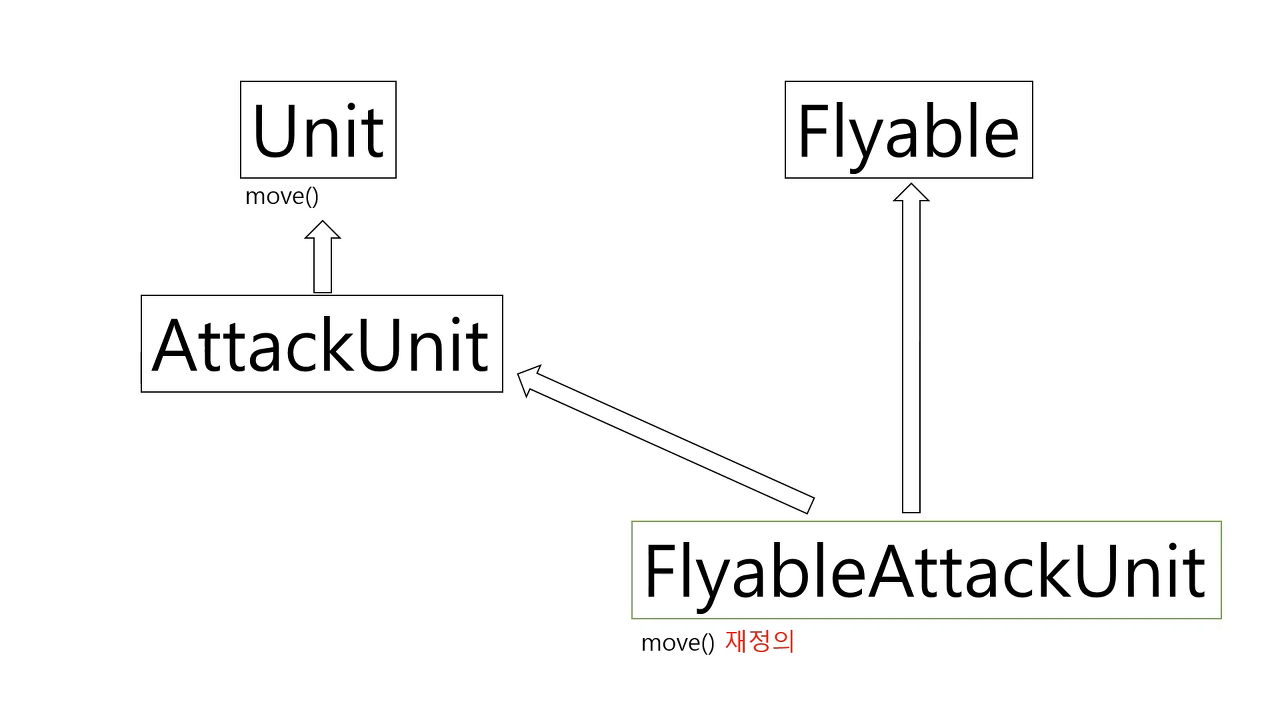클래스
1. 클래스의 필요성
-
ex)스타크래프트
마린
marine_name = "마린" # 이름
marine_hp = 40 # 체력
marine_damage = 5 # 공격력
print("{0} 유닛이 생성되었습니다.".format(marine_name))
print("체력 {0}, 공격력 {1}\n".format(marine_hp, marine_damage))
'''
마린 유닛이 생성되었습니다.
체력 40, 공격력 5
'''
탱크
tank_name = "탱크"
tank_hp = 150
tank_damage = 35
'''
탱크 유닛이 생성되었습니다.
체력 150, 공격력 35
'''
print("{} 유닛이 생성되었습니다.".format(tank_name))
print("체력 {0}, 공격력 {1}\n".format(tank_hp, tank_damage))
탱크 2
tank2_name = "탱크"
tank2_hp = 150
tank2_damage = 35
print("{} 유닛이 생성되었습니다.".format(tank2_name))
print("체력 {0}, 공격력 {1}\n".format(tank2_hp, tank2_damage))
이런 식으로 계속 하다간 너무 오래걸려 객체로 묶는 클래스로 구현하는 방법이 생겼다.
2. 클래스
-
구조
'''
class 클래스명:
def 메소드1(self, 전달값1, 전달값2, ...):
실행명령문1
실행명령문2
...
def 메소드2(self, 전달값1, 전달값2, ...):
실행명령문1
실행명령문2
...
'''
-
위 유닛들을 클래스로 작성
class Unit:
def __init__(self, name, hp, damage):
self.name = name #멤버변수
self.hp = hp #멤버변수
self.damage = damage #멤버변수
print("{} 유닛이 생성되었습니다.".format(self.name))
print("체력 {0}, 공격력 {1}".format(self.hp, self.damage))
marine = Unit("마린", 40, 5)
tank = Unit("탱크", 150, 35)
tank2 = Unit("탱크", 150, 35)
'''
마린 유닛이 생성되었습니다.
체력 40, 공격력 5
탱크 유닛이 생성되었습니다.
체력 150, 공격력 35
탱크 유닛이 생성되었습니다.
체력 150, 공격력 35
'''
3. init
init는 생성자와 같다. 사용자가 따로 호출하지 않아도 클래스 객체를 생성할 때 자동적으로 호출된다.
이 때, 전달값에 해당하는 갯수만큼 넘겨줘야한다.
예제) 위 코드를 기반으로 봤을때
marine2= Unit("마린")
# TypeError: __init__() missing 2 required positional arguments: 'hp' and 'damage'
위처럼 2개의 인자에 대한 값을 넘기라고 오류가 뜬다.
4. 멤버변수
클래스 내에서 정의된 변수, self.와 함께 사용
클래스 내에서는 self.로 멤버변수 접근
클래스 외부에서는 객체 이름뒤에 .을 찍고 접근
클로킹 기능
wraith = Unit("레이스", 80, 5)
print("유닛 이름 : {0}, 공격력 : {1}".format(wraith.name, wraith.damage))
# 마인드 컨트롤 상대방 유닛을 내 것으로 만듬
wraith2 = Unit("빼앗은 레이스", 80, 5)
# 클로킹 기능 있을경우
wraith2.cloaking = True
# 클로킹 확인
if wraith2.cloaking == True:
print("{0}은 클로킹 상태입니다.".format(wraith2.name)) #외부에서 호출하기때문에 객체이름뒤에 .으로 호출
이와 같이 클래스로부터 객체를 만든 다음 그 객체만을 위한 멤버 변수 정의가 필요한 경우
클래스 외부에서 별도로 정의할 수 있다.
객체만 아닌 그 인스턴스만 가능하다.
| wraith1의 멤버 변수 | wraith2의 멤버변수 |
|---|---|
| name | name |
| hp | hp |
| damage | damage |
| cloaking |
# 내가 만든 레이스 클로킹 확인
#if wraith1.cloaking == True:
# print("{0}은 클로킹 상태입니다.".format(wraith1.name))
# NameError: name 'wraith1' is not defined 다음과 같은 오류가 뜬다.
'''
# Unit클래스에는 3개의 멤버변수(name, hp, damage)밖에 없기 때문이다.
# wraith2는 클래스 외부에서 직접 cloaking이라는 멤버 변수를 정의했었기때문에
# 모든 Unit객체가 아닌 오직 wraith2에만 해당된다.
'''
5. 메소드
메소드는 한 클래스에서 여러가지함수를 작성할수 있다.
-
구조
Class A:
def 함수명:
# 공격형 유닛 클래스 작성
class AttackUnit:
def __init__(self, name, hp, damage):
self.name = name
self.hp = hp
self.damage = damage
def attack(self, location): # 공격 함수
print("{0} : {1}방향으로 적군을 공격합니다 . [ 공격력 {2} ]" \
.format(self.name, location, self.damage)) # 보기 좋게 두줄로 나눌때 \ 사용
# location 은 공격 방향이며, 명령을 받을 때마다 달라지고 외부에서 입력받기 때문에 self없이 전달
def damaged(self, damage): # 데미지를 받았을때
print("{0} : {1} 데미지를 입었습니다.".format(self.name, damage)) # 데미지 정보 출력
self.hp -= damage # 유닛의 체력에서 전달받은 damage 만큼 감소
print("{0} : 현재 체력은 {1} 입니다.".format(self.name, self.hp)) # 남은 체력 출력
if self.hp <= 0: # 남은 체력이 0 이하이면?
print("{0} : 파괴되었습니다.".format(self.name))
# 공격형 유닛 클래스 사용
firebat = AttackUnit("파이어뱃", 50, 16)
# 공격형 유닛의 함수 사용
firebat.attack("5시")
# 파이어뱃 : 5시방향으로 적군을 공격합니다. [ 공격력 16 ]
firebat.damaged(25) # 남은 체력 25
firebat.damaged(25) # 남은 체력 0 , 파괴
'''
파이어뱃 : 25 데미지를 입었습니다.
파이어뱃 : 현재 체력은 25 입니다.
파이어뱃 : 25 데미지를 입었습니다.
파이어뱃 : 현재 체력은 0 입니다.
파이어뱃 : 파괴되었습니다.
'''
6. 상속
공격형 유닛이 아닌 메딕을 만들어보자
Unit클래스와 Attack 클래스는 공통점이 있다. hp(체력)과 name(이름)이 있다는 점이다. 모든 유닛의 공통적인 부분일 것이고 이 부분을 Unit 클래스로 정의하면 나중에 다른 클래스(공격형,마법형) 등을 사용할때 상속하여 정의하면 된다.
-
구조
class 자식클래스(상속받을 부모클래스):
class Unit:
def __init__(self, name, hp):
self.name = name
self.hp = hp
class AttackUnit(Unit): #Unit를 상속받음
def __init__(self, name, hp, damage):
Unit.__init__(self, name, hp)
self.damage = damage
def attack(self, location):
print("{0} : {1}방향으로 적군을 공격합니다 . [ 공격력 {2} ]" \
.format(self.name, location, self.damage)) # 보기 좋게 두줄로 나눌때 \ 사용
# location 은 공격 방향이며, 명령을 받을 때마다 달라지고 외부에서 입력받기 때문에 self없이 전달
def damaged(self, damage):
print("{0} : {1} 데미지를 입었습니다.".format(self.name, damage)) # 데미지 정보 출력
self.hp -= damage # 유닛의 체력에서 전달받은 damage 만큼 감소
# self.damage가 아닌이유는 자기의 공격력이 아니라 외부에서 맞은 공격력이기때문이다.
print("{0} : 현재 체력은 {1} 입니다.".format(self.name, self.hp)) # 남은 체력 출력
if self.hp <= 0: # 남은 체력이 0 이하이면?
print("{0} : 파괴되었습니다.".format(self.name))
#파이어뱃 생성
firebat = AttackUnit("파이어뱃", 50, 16)
firebat.attack("5시") # 5시로 공격
# 파이어뱃 : 5시방향으로 적군을 공격합니다 . [ 공격력 16 ]
firebat.damaged(25) # 공격1번받음
#파이어뱃 : 25 데미지를 입었습니다.
#파이어뱃 : 현재 체력은 25 입니다.
7. 다중상속
공격력 없는 공중유닛 드랍쉽 공격력 있는 공중유닛 레이스 둘의 공통점 : 날 수 있다. 날 수 있는기능 클래스를 만들자 공통적으로 공중은 날라다니기때문에 클래스 함수로는 날라가기가 있다. ex) AttackUnit의 attack느낌
-
구조
class 자식클래스(부모클래스1, 부모클래스2, ...):

class Flyable:
def __init__(self, flying_speed):
self.flying_speed = flying_speed
def fly(self, name, location):
print("{0} : {1} 방향으로 날라갑니다. [ 속도 : {2} ] ".format(name, location, self.flying_speed))
#AttackUnit의 attack 함수내 name은 self.name이다. 하지만 여기선 생성자에서 name이 생성안되어서 그냥 name이다.
발키리 = 공중 + 공격유닛 다중상속을 사용하자
class FlyableAttackUnit(AttackUnit, Flyable):
def __init__(self, name, hp, damage, flying_speed):
AttackUnit.__init__(self, name, hp, damage)
Flyable.__init__(self, flying_speed)
# 발키리
valkyrie = FlyableAttackUnit("발키리", 200, 6, 5)
valkyrie.fly(valkyrie.name, "5시")
8. 오버라이딩
앞선 공중유닛에게는 공중속도(fly)가 있었다. 하지만 지상유닛도 지상속도(move)가 있다.
class Unit:
def __init__(self, name, hp, speed): #speed 추가
self.name = name
self.hp = hp
self.speed = speed
def move(self, location): # 이동함수
print(" {0} : {1} 방향으로 이동합니다. [ 속도 : {2} ]"\
.format(self.name, location, self.speed))
Unit를 상속받는 클래스에서도 speed를 추가해줘야한다.
class AttackUnit(Unit):
def __init__(self, name, hp, speed, damage): # speed 추가
Unit.__init__(self, name, hp, speed) # speed 추가
self.damage = damage
공중유닛은 지상속도가 0이기때문에 0을 대입해준다.
class FlyableAttackUnit(AttackUnit, Flyable):
def __init__(self, name, hp, damage, flying_speed):
AttackUnit.__init__(self, name, hp, 0, damage) # 지상 speed 0
Flyable.__init__(self, flying_speed)
# 지상유닛, 공중유닛 비교
# 벌쳐와 배틀크루져
# 벌쳐
vulture = AttackUnit("벌쳐", 80, 10, 20)
# 배틀크루져
battlecruiser = FlyableAttackUnit("배틀크루저", 500, 25, 3)
vulture.move("11시")
battlecruiser.fly(battlecruiser.name, "9시")
하지만 지상유닛의 이동과 공중유닛의 이동은 공중과 지상의 차이일뿐 결국 같은 개념이다. 오버라이딩 개념을 이용!
class FlyableAttackUnit(AttackUnit, Flyable):
def __init__(self, name, hp, damage, flying_speed):
AttackUnit.__init__(self, name, hp, 0, damage)
Flyable.__init__(self, flying_speed)
def move(self, location): # Unit 클래스의 move() 메소드를 새롭게 정의 (오버라이딩)
self.fly(self.name, location)
# 벌쳐
vulture = AttackUnit("벌쳐", 80, 10, 20)
# 배틀크루져
battlecruiser = FlyableAttackUnit("배틀크루저", 500, 25, 3)
vulture.move("11시")
battlecruiser.move("9시")
'''
벌쳐 : 11시 방향으로 이동합니다. [ 속도 : 10 ]
배틀크루저 : 9시 방향으로 날라갑니다. [ 속도 : 3 ]
'''
-
현재까지 전체코드
# 일반 유닛
class Unit:
def __init__(self, name, hp, speed):
self.name = name
self.hp = hp
self.speed = speed
print("{0} 유닛이 생성되었습니다.".format(name))
def move(self, location):
print("[지상 유닛 이동]")
print("{0} : {1} 방향으로 이동합니다. [속도 {2}]"\
.format(self.name, location, self.speed))
# 공격 유닛
class AttackUnit(Unit):
def __init__(self, name, hp, speed, damage):
Unit.__init__(self, name, hp, speed)
self.damage = damage
def attack(self, location):
print("{0} : {1} 방향으로 적군을 공격 합니다. [공격력 {2}]" \
.format(self.name, location, self.damage))
def damaged(self, damage):
print("{0} : {1} 데미지를 입었습니다.".format(self.name, damage))
self.hp -= damage
print("{0} : 현재 체력은 {1} 입니다.".format(self.name, self.hp))
if self.hp <= 0:
print("{0} : 파괴되었습니다.".format(self.name))
# 날 수 있는 기능을 가진 클래스
class Flyable:
def __init__(self, flying_speed):
self.flying_speed = flying_speed
def fly(self, name, location):
print("{0} : {1} 방향으로 날아갑니다. [속도 {2}]"\
.format(name, location, self.flying_speed))
# 공중 공격 유닛
class FlyableAttackUnit(AttackUnit, Flyable):
def __init__(self, name, hp, damage, flying_speed):
AttackUnit.__init__(self, name, hp, 0, damage)
Flyable.__init__(self, flying_speed)
def move(self, location):
print("[공중 유닛 이동]")
self.fly(self.name, location)
# 벌쳐 : 지상 유닛, 기동성이 좋음
vulture = AttackUnit("벌쳐", 80, 10, 20) # 지상 speed 10
# 배틀크루저 : 공중 유닛, 체력도 굉장히 좋음, 공격력도 좋음
battlecruiser = FlyableAttackUnit("배틀크루저", 500, 25, 3)
vulture.move("11시")
# battlecruiser.fly(battlecruiser.name, "9시")
battlecruiser.move("9시") # 오버라이딩된 move() 호출
9. pass
함수를 다 작성하지 않아도 오류가 생기지 않는다.
미완성하거나 나중에 작성할 것을 pass함수를 사용하면 된다.
# 건물 클래스작성
class BuildingUnit(Unit):
def __init__(self, name, hp, location):
pass
supply_depot = BuildingUnit("서플라이 디폿", 500, "7시")
# 실행시 오류가 없다.
10. super
super는 부모클래스에 접근하는 것
class BuildingUnit(Unit):
def __init__(self, name, hp, location):
super().__init__(name, hp, 0)
# super().__init__(self, name, hp, 0) self는 제외
# = Unit.__init__(self, name, hp, 0)
self.location = location
Q) 만약 부모클래스가 두개라면?
A) 제일 먼저 선언된 부모클래스로 한다.
class Unit:
def __init__(self):
print("Unit 생성자")
class Flyable:
def __init__(self):
print("Flyable 생성자")
class FlyableUnit(Unit, Flyable):
def __init__(self):
super().__init__()
dropship = FlyableUnit()
# Unit 생성자
super는 제일 먼저 생성된 Unit로 인식하는 것을 확인할 수 있다.
11. 클래스 변수
클래스 변수는 클래스 이름과 함께 어디서든지 사용가능. 멤버변수는 각 클래스 객체마다 다른 값을 가진다면 클래스 변수는 모든 객체가 동일한 값을 가진다
-
구조
class 클래스명:
클래스변수 = False
def __init__(self)
-
예제
시즈모드
class Tank(AttackUnit):
siege_developed = False # 시즈모드가 개발되었나.
#클래스변수
def __init__(self):
AttackUnit.__init__(self, "탱크", 150, 1, 35)
self.siege_mode = False # 처음엔 시즈모드 해체상태이다.
#시즈모드
def set_siege_mode(self):
if Tank.siege_developed == False: # 시즈모드개발이 안됐을경우, 메소드 탈출
return # 클래스변수는 self가아니라 Tank(객체)로 선언해줘야한다.
if self.siege_mode == True:
print("{0} : 시즈모드를 해체합니다.".format(self.name))
self.damage /= 2
self.siege_mode = False
else:
print("{0} : 시즈모드를 시작합니다.".format(self.name))
self.damage *= 2
self.siege_mode = True
마린
class Marine(AttackUnit):
def __init__(self):
AttackUnit.__init__(self, "마린", 40, 1, 5) # 이름, 체력, 이동속도, 공격력
# 스팀팩 : 일정 시간 동안 이동 및 공격 속도를 증가, 체력 10 감소
def stimpack(self):
if self.hp > 10:
self.hp -= 10
print("{0} : 스팀팩을 사용합니다. (HP 10 감소)".format(self.name))
else:
print("{0} : 체력이 부족하여 스팀팩을 사용하지 않습니다".format(self.name))
마린생성
m1 = Marine()
m2 = Marine()
m3 = Marine()
탱크생성
t1 = Tank()
t2 = Tank()
유닛관리(부대지정) / append사용
attack_units = []
attack_units.append(m1)
attack_units.append(m2)
attack_units.append(m3)
attack_units.append(t1)
attack_units.append(t2)
for unit in attack_units:
unit.move("1시")

12. 인스턴스
객체가 특정 인스턴스인지 여부를 확인 각 유닛 객체들이 Marine 클래스의 인스턴스인지 Tank인지 여부 확인
-
구조
isinstance(객체, 클래스)
# 시즈모드 개발
Tank.siege_developed = True # 클래스변수이기때문에 클래스명 사용
print("시즈모드 개발 완료")
for unit in attack_units:
if isinstance(unit,Marine):
unit.stimpack()
elif isinstance(unit, Tank):
unit.set_siege_mode()
else:
print("잘못된 값입니다.")
for unit in attack_units:
unit.attack("1시")
from random import *
for unit in attack_units:
unit.damaged(randint(5, 20))
13. 퀴즈
-
문제
Quiz) 주어진 코드를 활용하여 부동산 프로그램을 작성하시오.
(출력 예제)
총 3대의 매물이 있습니다.
강남 아파트 매매 10억 2010년
마포 오피스텔 전세 5억 2007년
송파 빌라 월세 500/50 2000년
-
해답
class House:
# 매물 초기화 : 위치, 건물 종류, 매물 종류, 가격, 준공년도
def __init__(self, location, house_type, deal_type, price, completion_year):
self.location = location
self. house_type = house_type
self.deal_type = deal_type
self.price = price
self.completion_year = completion_year
# 매물 정보 표시
def show_detail(self):
print("{0} {1} {2} {3}억 {4}년"\
.format(self.location, self.house_type, self.deal_type,\
self.price, self.completion_year))
house1 = House("강남", "아파트", "매매", 10, 2010)
house2 = House("마포", "오피스텔", "전세", 5, 2007)
house3 = House("송파", "빌라", "월세", 500, 2000)
houses = []
houses.append(house1)
houses.append(house2)
houses.append(house3)
for house in houses:
house.show_detail()




댓글 쓰기